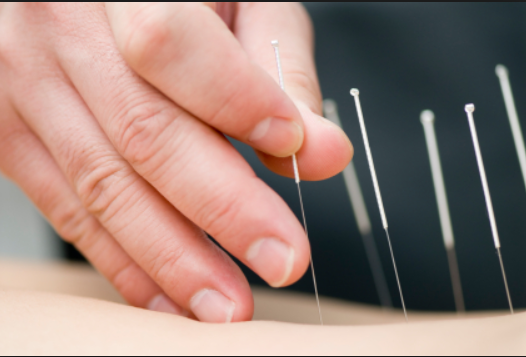
What is acupuncture?
Acupuncture is a 3,000-year-old healing technique of Traditional Chinese Medicine. In 1997, the U.S. National Institutes of Health (NIH) documented and publicized acupuncture’s safety and efficacy for treating a wide range of conditions. Acupuncture is now covered by many insurance policies and is used most broadly to relieve pain.
How does acupuncture work?
Acupuncture improves the body’s functions and promotes the natural self-healing process by stimulating specific anatomic sites–commonly referred to as acupuncture points, or acupoints. The most common method used to stimulate acupoints is the insertion of fine, sterile needles into the skin. Pressure, heat, or electrical stimulation may further enhance the effects. Other acupoint stimulation techniques include: manual massage, moxibustion or heat therapy, cupping, and the application of topical herbal medicines and linaments.
Traditional Chinese Medicine is based on an ancient philosophy that describes the universe, and the body, in terms of two opposing forces: yin and yang. When these forces are in balance, the body is healthy. Energy, called “qi” (pronounced “chee”) flows along specific pathways, called meridians, throughout the body. This constant flow of energy keeps the yin and yang forces balanced. However, if the flow of energy gets blocked, like water getting stuck behind a dam, the disruption can lead to pain, lack of function, or illness. Acupuncture therapy can release blocked qi in the body and stimulate function, evoking the body’s natural healing response through various physiological systems. Modern research has demonstrated acupuncture’s effects on the nervous system, endocrine and immune systems, cardiovascular system, and digestive system. By stimulating the body’s various systems, acupuncture can help to resolve pain, and improve sleep, digestive function, and sense of well-being.
- Musculoskeletal: Frozen Shoulder, Tennis Elbow, Carpal Tunnel Syndrome, Low Back Pain, Sciatica, Arthritis, Hip & Knee pain
- Neurological: Chronic Fatigue, Headache, Migraine, Fibromyalgia
- Female Issues: PMS, Menstrual Cramps, Irregular menses, Infertility
- Intestinal: Chronic Gastritis, GERD (Heartburn), Chronic Ulcers, IBS, Constipation, Diarrhea
- Psychiatri: Stress, Anxiety, Depression, Insomnia
Please call if you have questions about a condition not listed
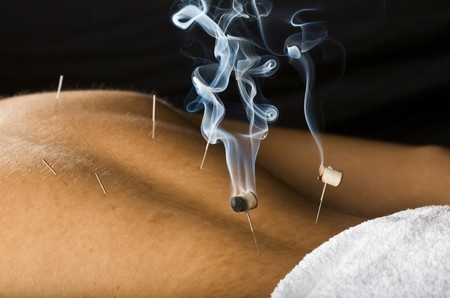
What is moxibustion?
Moxibustion is a form of heat therapy in which dried plant materials called “moxa” are burned on or very near the surface of the skin. The intention is to warm and invigorate the flow of Qi in the body and dispel certain pathogenic influences. Moxa is usually made from the dried leafy material of Chinese mugwort (Artemesia argyi or A.vlugaris), but it can be made of other substances as well.
What exactly does the practitioner do?
In the U.S., practitioners generally hold a burning moxa stick close to, but not touching, the surface of the skin. In this method, the moxa material is compressed into a stick or pole, looking not unlike an oversized cigar that can be lit and allowed to smolder, producing a unique form of very penetrating heat. The smoldering moxa stick is held over specific areas, often, though not always, corresponding to certain acupuncture points. The glowing end of the moxa stick is held about an inch or two above the surface of the skin until the area reddens and becomes suffused with warmth.
What can I expect to feel?
It is not uncommon for patients receiving moxibustion to report a sudden flooding of warmth that quickly radiates along a specific pathway (usually corresponding with the jing luo channel that is being treated) away from the site of application. This is a good result, as it indicates the arrival of the Qi and signals that the flow of Qi and xue has been freed in the channel.
When is moxibustion used?
Moxibustion is used for:
Pain due to injury or arthritis, especially in “cold” patterns where the pain naturally feels better with the application of heat
- Digestive problems and irregular elimination
- Gynecological and obstetrical conditions, including breech presentation in late term pregnancy
- Protection against cold and flu strains
Practitioners often do both acupuncture and moxibustion in the same clinic session when appropriate to the diagnosis and treatment strategy. Practitioners believe that the therapies increase each other’s effectiveness when used together. Unlike acupuncture, which is almost always done by a trained practitioner in a clinic setting, moxibustion can be easily used at home. It is not uncommon for Chinese medical practitioners to train their patients to use moxa on themselves to strengthen the effect of the clinical sessions between appointments.
What does it smell like?
There is a small inconvenience associated with moxibustion: the smoke and odor. Although there are so-called smokeless varieties of moxa, the preferred true moxa (made from mugwort) does produce a lot of smoke when burned. Most TCM clinics are well equipped with a good ventilation and air purification system, so this is not a big problem.However, the lingering odor produced from burning mugwort unfortunately smells somewhat like marijuana. Most TCM practitioners in the United States, place small signs around their office informing patients and visitors about the true nature of the odor that they may be noticing.
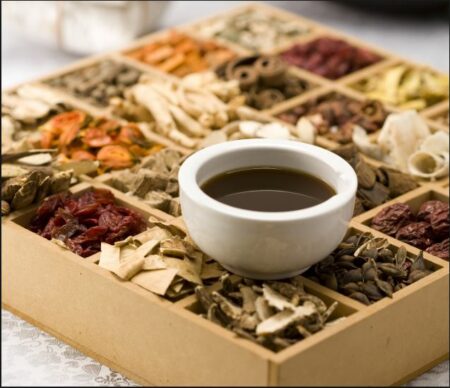
What Is Herbal Medicine?
Herbal medicine, also known as herbalism or botanical medicine, is a medical system based on the use of plants or plant extracts that may be eaten or applied to the skin. Since ancient times, herbal medicine has been used by many different cultures throughout the world to treat illness and to assist bodily functions. While herbal medicine is not a licensed profession in the United States, herbal remedies in the form of extracts, tinctures, capsules and tablets as well as teas may be recommended by healthcare practitioners of many different disciplines as a practical way to address a wide variety of medical conditions.
Herbal medicine blurs the line between foods and medicines – a line that, in many cultures, was never drawn in the first place. Using herbs and spices that have disease-preventive effect in foods is one of the best ways to take advantage of their healing power. For example, it appears that the daily use of the spice turmeric in curry dishes is one reason elderly people in India have one of the lowest rates of Alzheimer’s disease in the world.
What Conditions Is Herbal Medicine Used For?
Herbal medicine has been used to treat or alleviate virtually every possible medical condition. Some of the most popular herbal remedies and the conditions for which they are used include:
- also used topically for minor burns, sunburns, skin irritation or inflammation
- arnica used topically for bruises, sprains, sore muscles and joints
- chamomile tea ingested for upset stomach, heartburn, indigestion and colic
- comfrey, in a topical poultice only, for bedsores, diabetic ulcers, certain spider bites and staph infections contracted on tropical beaches
- dong quai for women and ginseng for men and women, ingested to improve general health and stamina – in this application, these are known as tonics. Other tonics include eleuthero and rhodiola.
- echinacea ingested for colds, flu, sore throat
- garlic ingested to possibly reduce cholesterol and blood pressure, treat fungal infections and
- ginger ingested for nausea and motion sickness and as an anti-inflammatory
- mullein ingested for chest congestion and dry, bronchial coughs
- passionflower ingested for non-sedating relaxation
- peppermint tea ingested for indigestion, nausea and other digestive problems
- peppermint oil (in enteric-coated capsules) ingested for irritable bowel syndrome and other chronic intestinal ailments
- tea tree oil applied topically for fungal infections such as athlete’s foot and fungal infections of the toenails and fingernails
- turmeric ingested to combat inflammation and protect against cancer and Alzheimer’s disease
- valerian ingested for sleeping problems.

What is cupping?
Cupping therapy is an ancient form of alternative medicine in which a therapist puts special cups on your skin for a few minutes to create suction. People get it for many purposes, including to help with pain, inflammation, blood flow, relaxation and well-being, and as a type of deep-tissue massage.
The cups may be made of:
- Glass
- Bamboo
- Earthenware
- Silicone
Cupping therapy might be trendy now, but it’s not new. It dates back to ancient Egyptian, Chinese, and Middle Eastern cultures. One of the oldest medical textbooks in the world, the Ebers Papyrus, describes how the ancient Egyptians used cupping therapy in 1,550 B.C.
Types
There are different methods of cupping, including:
- Dry
- Wet
YOU MIGHT LIKE
During both types of cupping, your therapist will put a flammable substance such as alcohol, herbs, or paper in a cup and set it on fire. As the fire goes out, he puts the cup upside down on your skin.
As the air inside the cup cools, it creates a vacuum. This causes your skin to rise and redden as your blood vessels expand. The cup is generally left in place for up to 3 minutes.
A more modern version of cupping uses a rubber pump instead of fire to create the vacuum inside the cup. Sometimes therapists use silicone cups, which they can move from place to place on your skin for a massage-like effect.
Wet cupping creates a mild suction by leaving a cup in place for about 3 minutes. The therapist then removes the cup and uses a small scalpel to make light, tiny cuts on your skin. Next, he or she does a second suction to draw out a small quantity of blood.
You might get 3-5 cups in your first session. Or you might just try one to see how it goes. It’s rare to get more than 5-7 cups, the British Cupping Society notes.
Afterward, you may get an antibiotic ointment and bandage to prevent infection. Your skin should look normal again within 10 days.
Cupping therapy supporters believe that wet cupping removes harmful substances and toxins from the body to promote healing. But that’s not proven.
Some people also get “needle cupping,” in which the therapist first inserts acupuncture needles and then puts cups over them.
What Does the Research Show?
There haven’t been many scientific studies on cupping.
One report, published in 2015 in the Journal of Traditional and Complementary Medicine, notes that it could help with acne, herpes zoster, and pain management.
That’s similar to the findings from a 2012 report, published in PLoS One. Australian and Chinese researchers reviewed 135 studies on cupping. They concluded that cupping therapy may be effective when people also get other treatments, like acupuncture or medications, for various diseases and conditions, such as:
- Herpes zoster
- Acne
- Facial paralysis
- Cervical spondylosis
But those researchers noted many of the studies they reviewed could have been biased and that better studies are needed.
The British Cupping Society says that cupping therapy is used to treat:
- Blood disorders such as anemia and hemophilia
- Rheumatic diseases such as arthritis and fibromyalgia
- Fertility and gynecological disorders
- Skin problems such as eczema and acne
- High blood pressure
- Migraines
- Anxiety and depression
- Bronchial congestion caused by allergies and asthma
- Varicose veins
There isn’t research to back all of that up.
Side Effects
Cupping is fairly safe, as long as you go to a trained health professional. But you could have these side effects in the area where the cups touch your skin:
- Mild discomfort
- Burns
- Bruises
- Skin infection
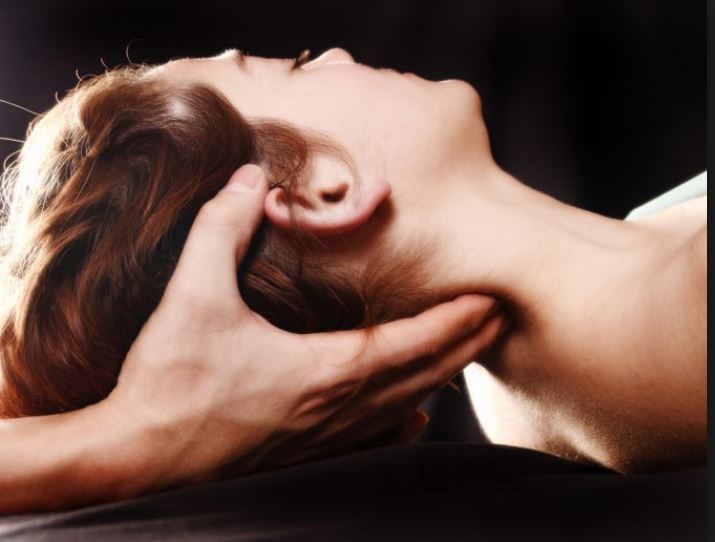
What is acupressure?
Acupressure is a therapy developed over 5,000 years ago as an important aspect of Asian, especially Chinese, medicine. It uses precise finger placement and pressure over specific points along the body. These points follow specific channels, known as meridians – the same channels used in acupuncture. According to Asian medical philosophy, activation of these points with pressure (or needles) can improve blood flow, release tension, and enhance or unblock life-energy, known in China as “qi” or in the English-speaking world as “chi.” This release allows energy to flow more freely through the meridians, promoting relaxation, healing and the restoration of proper function.
It should be noted that the existence of qi and meridians is doubted by many Western scientists. According to this skeptical view, any healing effect from acupuncture or acupressure sessions is not due to the alteration of subtle energy flows along invisible channels, but rather to the same gross physical effects that happen during any kind of massage therapy, including muscular relaxation and improved regional blood flow.
What conditions is acupressure used for?
Acupressure therapy can be used to relieve pain, reduce tension in muscles, improve circulation and promote deep states of relaxation. It is often done by massage therapists and other bodyworkers, but can also be learned as a technique to be done oneself. Individuals can be treated, then trained in various self-care applications and pressure-point formulas for specific conditions. These include nausea and vomiting, motion sickness, headaches, neck and back pain, as well as chronic fatigue, fibromyalgia, mental and emotional stress, even addiction recovery and learning disorders.
For centuries, the Chinese have used acupressure points as a beauty treatment to enhance muscle tone and increase circulation, especially of facial muscles. This can reportedly improve the condition and appearance of the skin, lessening wrinkles and sagging of the face without drugs or surgery, although clinical trials are needed to confirm this. Acupressure points have also been employed to increase arousal, decrease sexual tension and reportedly aid in alleviating sexual dysfunction, including infertility, decreased sexual desire, premature ejaculation, and impotency.
What should one expect on a visit to a practitioner?
An acupressure session is typically performed with the patient lying on a massage table, though it can be used in conjunction with exercises such as tai chi or qi gong. As stated, one can also learn acupressure as a self-care strategy, utilizing the techniques any time it is desired.
Typical sessions with a practitioner might last 45-90 minutes and are often done in conjunction with some form of massage therapy. This means that the same acupressure points may be manipulated with various rhythms and pressures, using the fingers, hands, arms, elbows, even legs and feet.
The recipient should wear comfortable, loose-fitting clothing, such as that typically worn while exercising or doing yoga. Slow, full, deep breathing is often encouraged, especially with pressure applied to points that cause discomfort or that the practitioner regards as having blocked energy. Guided imagery or visualization is often added to allow further relaxation or movement of energy to and through pressure points.
Following treatment, a practitioner may ask for feedback and offer home exercises or self-care. Because energy work of any kind can cause profound relaxation, care should always be used when rising from the table and returning to a standing posture, as the leg and trunk muscles may feel weak for a time.
Are there any situations where acupressure should be avoided? Acupressure should not be considered primary treatment for serious illness, and should be used with care during pregnancy as certain points are thought to stimulate uterine contractions. Pressure should not be exerted over areas with burns, infection, contagious diseases of the skin or active cancer.
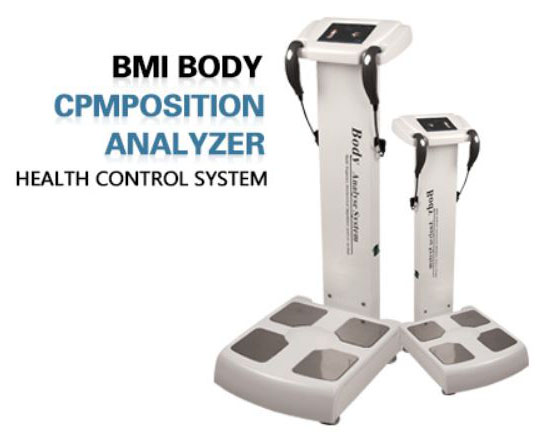
Other therapeutic procedures
we offer include: TDP Lamp for promoting circulation and healing of deep tissues, Hot pack for relife pain, Ear Seedsand Ear needls for extension of treatment, BMI analysis for body fat and other Chinese medical procedures and therapeutictechniques.

